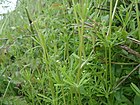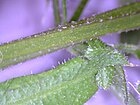Note: This is a project under development. The articles on this wiki are just being initiated and broadly incomplete. You can Help creating new pages.
Difference between revisions of "Galium aparine"
| Line 1: | Line 1: | ||
[[File:Cleavers (Galium aparine) (3561906713).jpg|thumb|right]] | [[File:Cleavers (Galium aparine) (3561906713).jpg|thumb|right]] | ||
| − | '''Galium aparine''' is a annual growing plant. It is in flower from June to August. It's seeds ripen from August to September. The species is hermaphrodite (has both male and female organs) and is pollinated by Flies, beetles. The plant is self-fertile. | + | '''Galium aparine''' is a annual growing plant. It is in flower from June to August. It's seeds ripen from August to September. The species is hermaphrodite (has both male and female organs) and is pollinated by Flies, beetles. The plant is self-fertile. It is noted for attracting wildlife. |
| − | It is noted for attracting wildlife. | ||
==Uses== | ==Uses== | ||
{{Uses|Cancer}}, {{Uses|Skin problems}}.<ref name="Uses"/> | {{Uses|Cancer}}, {{Uses|Skin problems}}.<ref name="Uses"/> | ||
| Line 12: | Line 11: | ||
==Common names== | ==Common names== | ||
| − | {{Common names|sa=|en=|gu=|hi=|kn=|ks=|ml=|mr=|pa=|ta=|te=}} | + | {{Common names|sa=|en=Goose Grass, Cleavers|gu=|hi=Kuri|kn=|ks=|ml=|mr=|pa=|ta=|te=}} |
==Properties== | ==Properties== | ||
Latest revision as of 15:13, 22 May 2020
Galium aparine is a annual growing plant. It is in flower from June to August. It's seeds ripen from August to September. The species is hermaphrodite (has both male and female organs) and is pollinated by Flies, beetles. The plant is self-fertile. It is noted for attracting wildlife.
Contents
- 1 Uses
- 2 Parts Used
- 3 Chemical Composition
- 4 Common names
- 5 Properties
- 6 Habit
- 7 Identification
- 8 List of Ayurvedic medicine in which the herb is used
- 9 Where to get the saplings
- 10 Mode of Propagation
- 11 How to plant/cultivate
- 12 Commonly seen growing in areas
- 13 Photo Gallery
- 14 References
- 15 External Links
Uses
Parts Used
Chemical Composition
Common names
| Language | Common name |
|---|---|
| Kannada | |
| Hindi | Kuri |
| Malayalam | |
| Tamil | |
| Telugu | |
| Marathi | |
| Gujarathi | |
| Punjabi | |
| Kashmiri | |
| Sanskrit | |
| English | Goose Grass, Cleavers |
Properties
Reference: Dravya - Substance, Rasa - Taste, Guna - Qualities, Veerya - Potency, Vipaka - Post-digesion effect, Karma - Pharmacological activity, Prabhava - Therepeutics.
Dravya
Rasa
Guna
Veerya
Vipaka
Karma
Prabhava
Habit
[[:Category:Habit - |]]
Identification
Leaf
| Kind | Shape | Feature |
|---|---|---|
Flower
| Type | Size | Color and composition | Stamen | More information |
|---|---|---|---|---|
| {{{5}}} |
Fruit
| Type | Size | Mass | Appearance | Seeds | More information |
|---|---|---|---|---|---|
Other features
List of Ayurvedic medicine in which the herb is used
Where to get the saplings
Mode of Propagation
How to plant/cultivate
Prefers a loose moist leafy soil in some shades. Plants tolerate dry soils, but they quickly become scorched when growing in full sun.[4]
Commonly seen growing in areas
Woodland Garden Dappled Shade, Shady Edge, Deep Shade, Hedgerow.
Photo Gallery
References
- ↑ Indian Medicinal Plants by C.P.Khare
- ↑ [Chemistry]
- ↑ [Morphology]
- ↑ Cultivation
External Links
- Ayurvedic Herbs known to be helpful to treat Cancer
- Ayurvedic Herbs known to be helpful to treat Skin problems
- Herbs with Leaves used in medicine
- Herbs with common name in Hindi
- Herbs with common name in English
- Habit -
- Index of Plants which can be propagated by Seeds
- Herbs that are commonly seen in the region of Woodland Garden Dappled Shade
- Herbs that are commonly seen in the region of Shady Edge
- Herbs that are commonly seen in the region of Deep Shade
- Herbs that are commonly seen in the region of Hedgerow
- Herbs
- Pages without herbs images





